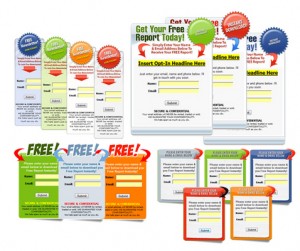Anyone who’s my age probably remembers spending a late night or two watching a funny little man on tv telling us how he was able to make $50,000 a week “placing tiny classified ads in newspapers” from his “one-bedroom apartment”. Right in those two quotes, you have the makings of a very successful infomercial—mention how lots of money can be made with seemingly little work and cater to others who might be living in a one-bedroom apartment as these people are likely to want an opportunity that will change their lives.
If you have no idea who I’m talking about, check out this video…it’s exactly what I remember when I was younger:
First of all, this guy is good and there’s no doubt about it. As a firm believer that hard work pays off and there’s no easy way of making lots of money, I never “fell” for one his claims, but I will admit that there were a few times when it seemed like the plan would work. More importantly, there are many other people out there that are worse off than me financially and just might jump at the chance to make even 100 more dollars a week.
The indictment
Don Lapre has been running infomercials like these for the last 8 years or so selling all sorts of money-making packages that are guaranteed to turn your life around. The two most prominent ones include the one above and another selling the The Greatest Vitamin in the World. This is the one that’s garnered the attention of the Feds and the United States Postal Service.
According to the case, Don Lapre is being indicted on 41 counts of conspiracy, mail fraud, wire fraud and promotional money laundering. It’s being claimed that he bilked over $52 million from some 200,000 unsuspecting consumers. Essentially, he’s being accused of running a nationwide scheme to sell worthless internet businesses.
The program
I don’t want to get into all the details here because the case file says it all in a 28-page PDF document available from Casewatch.org, but I do want to briefly explain what it is that Don Lapre does. Using The Greatest Vitamin in the World program as an example, this is how the program works.
- Watch Don’s infomercial and get excited about the potential of making lots of money.
- Call the 800 number to order the start-up package and personal website for $35.00 plus $13.65 shipping.
- Don’s reps would then call back consumers telling them that there were more fees in running the personal website including a $295 setup fee and $9.95 per month hosting fees.
- Don’s reps would try to upsell customers into buying web traffic for their new site guaranteeing them that people would come to the site and buy products or signup as new “investors”.
- Customers buy traffic packages ranging in price from $500-2000.
- Customers are offered sales incentives: Get 20 new people to sign up for the program and get $1000. Get 100 new vitamin customers in a month and get $10,000. For every 5 $1000 bonuses you earn, you get a 7-day paid vacation for 2.
My two cents
First of all, the vitamins are worthless. To Don, getting new sales people all dropping about $3000 to start their own business is where the money really is. Unfortunately, this is nothing more than a pyramid scheme. The ones at the top who are able to get to everyone who hasn’t joined yet will make all the referral fees. The ones at the bottom will have nobody to recruit because they’ve all been recruited…after some time, the pyramid crumbles because there’s nothing left to do but sell worthless vitamins and the guys at the top take their money and run.
Second, if you really think about it, why would Don Lapre (or any tv pitchman) want to tell you his money-making secrets if what he’s doing already makes him so much money? Do you really believe he’s out there trying to help the community? Do you really think he cares about helping you make more money in life? The answer is no. It’s the tell-tale sign of a scam and it’s no different than all those bloggers out there selling you $47 money-making plans that tell you all the secrets of Internet marketing. Trust me, if I discovered a way to make $50,000 a week, I wouldn’t tell anyone! Not because I’m selfish, but because I wouldn’t want to create thousands of competitors out there. If there’s only $50,000 to be made, that means I’d have to share it with everyone else who copies me. That’s not a good business plan!
I’ll tell you a secret. There are no secret ways to make money! There are however innovative ideas that will make someone millions one day, but those aren’t secrets—sometimes those are flukes or fads or streaks of luck. Facebook is a perfect example—sheer luck. The point is to make real money, you have to put in real work. If you think you’re going to make $50,000 a week with only a few minutes of work, you’re either delusional or you’re the one sitting on top of the pyramid because in any other situation, you’re not going to make anything close to that.
Ok, I’m done venting…the last thing I want to say is that I hope Don Lapre goes away forever! He’s a con artist and a thief. At the same time, I hope none of those people get their money back so maybe they’ll learn from their mistakes.

 help with this. Here are a few tips you can use to create buzz around your newsletter.
help with this. Here are a few tips you can use to create buzz around your newsletter. interested users from all over the Internet–usually thousands of varying websites with numerous topics. They collect all of these emails and separate them into applicable categories and lists and then sell them to other websites to use in their marketing plans.
interested users from all over the Internet–usually thousands of varying websites with numerous topics. They collect all of these emails and separate them into applicable categories and lists and then sell them to other websites to use in their marketing plans. Your website is no exception. There’s no sense in promoting your products and services to people who have no interest in using them. Learning your demographics for your niche or market will help you find people in particular age groups, cultural societies and various interests groups that fit your ideal customer. Knowing this information will help you better serve your customers and allow you to market specific segments of your business. The hard (and expensive) part is finding out who your customers really are.
Your website is no exception. There’s no sense in promoting your products and services to people who have no interest in using them. Learning your demographics for your niche or market will help you find people in particular age groups, cultural societies and various interests groups that fit your ideal customer. Knowing this information will help you better serve your customers and allow you to market specific segments of your business. The hard (and expensive) part is finding out who your customers really are. you get the chance, but don’t force it in your visitors’ faces. You may have seen websites that throw out popup or popunder windows and you already know how annoying these are.
you get the chance, but don’t force it in your visitors’ faces. You may have seen websites that throw out popup or popunder windows and you already know how annoying these are.
 For a website example, lets look at my site. The most closely related tribal group I can relate to would be business owners, bloggers, website developers and Internet marketers. What this means is that my content will strike a chord with people in these groups and they’re more likely to respond to my offerings.
For a website example, lets look at my site. The most closely related tribal group I can relate to would be business owners, bloggers, website developers and Internet marketers. What this means is that my content will strike a chord with people in these groups and they’re more likely to respond to my offerings.
